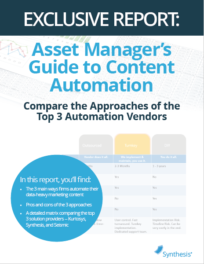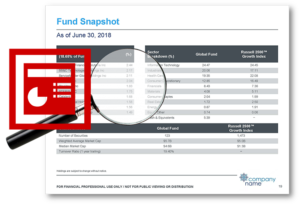The Scaling Problem in Investment Management Marketing

I had conversations this week with two new prospective investment management clients. Each expressed a “scaling problem” with marketing efforts as being their chief reason for looking into document and data automation.
I very much like that phrase. It’s straight out of my pitchbook on how a solution like Synthesis solves problems with scaling investment management marketing. I usually define a scaling problem as:
The point in time in which either the number of documents, users, staff required, or variety of documents to meet the communication needs has passed some tipping point.
My takeaway from these two conversations is quite interesting. Although each firm was experiencing valid issues, the firm profiles and the scope of their work was vastly different. The key to efficient and profitable growth is scalability.
Scaling problems don’t look the same at every firm
The two firms I spoke with represented opposite ends of the spectrum of Investment Management companies. One is very small and one very large, but their scaling problems and need for solutions are equally legitimate.
One is a US-based asset manager that represents seven investment products and updates its material quarterly. This firm produces about 50 pages of literature a month. The second firm is European-based with around 60 products, publishing in multiple languages, separate share-classes, and updating its material monthly. This firm is producing over 1500 pages per month.
Currently, both firms successfully produce fact sheets and other literature using available tools and staff, but both are approaching their limits. Each firm is looking for something better — something that can scale.
What causes an investment management marketing scaling problem?
How can firms producing 50 pages of literature and over 1,500 pages define their problem as the same?
I have two answers to this and they dove-tail quite well.
1) The current system and process built for communication needs to satisfy the firm has now changed.
2) The current market demands a greater variety of literature than ever before. This is driving the need for better systems and processes across the spectrum of firms.
I’ve seen all the tidal forces of change over the last 20+ years in the industry. Two decades ago, marketing teams produced factsheets and performance guides, and that was pretty much it. The website usually consisted of a variation on this same content. However, in most cases, it was managed separately from the marketing collateral. Sometimes, 300 or 400-word commentaries were a part of the document mix. Those have since started dropping due to low engagement and a serious impediment in time-to-market.
Content marketing is disrupting the collateral environment
Compare that with today’s collateral environment. This is the age of content marketing and thought leadership. So, marketing teams are charged with producing a greater variety of materials. These materials are designed to promote the firm and its sales groups as true thought leaders and innovators in the industry. What’s more, it turns out that people actually read this material now.
Thus, with contribution from product management or a financial writing team, the marketing group is now in the business of producing factsheets, commentaries, market guides, sales ideas, custom pitch-books, product guides, performance summaries, newsletters, and a website loaded with fresh content and eye-popping interactive tools.
The demand for content at smaller vs. larger firms
Surprisingly, there is actually a higher demand for content at smaller firms. We find that firms with around 15 products are producing more pages of literature per product than the big guys. And there is a payoff for this. The smaller firms build a reputation for a specific market or strategy expertise, whereas larger firms trade principally on their brand status and clout.
In fact, one major firm I know of is actually making moves to decrease the responsiveness of their literature to market content requirements. The logic being that brand consistency and cost management is more important than driving market-tuned and channel-specific content into the field. Personally, I feel this is a huge mistake.
Whether you represent a boutique firm or a market behemoth, the recipe for beating the scaling problem is the same. And it’s not “stop producing quality content.”
Content is king. Without a proper way to produce and manage it, you will experience a scaling problem that could unravel marketing efforts.
Use a content-managed approach to the problem
A well-organized and flexible content production and management infrastructure makes scaling in volume and/or variety an achievable goal. We define content as anything that isn’t data. Actually, data is content, too. But, we like to treat data separately from language or graphical content. It usually has a completely different life cycle. Content is your descriptions, disclosures, stories, articles, and graphics. An effective content management approach that solves the scaling problem for investment management marketing requires a few specific elements:
1. A data management approach that supports marketing
Many firms have rudimentary central data warehouses in place. The goal is to create a platform that really embraces data stewardship and reporting-side utility. A strong database doesn’t leave data cleanup and delivery to the marketing and e-business teams. Though, it does require focus and experience to reach a scalable outcome. If the data is warehoused well, tested, validated, and approved, then it should be easy to extract or deliver readily.
2. Central management of content and data that supports reusability
Preparing effective and targeted literature and websites is easy when the data and content are managed centrally, flexibly, and intelligently. The key is to store all that material in a useful, but use-agnostic format. If the content is organized and managed with consistency and re-use in mind, then producing widening ranges of content shouldn’t be that hard.
3. A system that embraces compliance needs
Additionally, content management, data management and proper data stewardship represent a significant reduction in risk to the firm. Taking these ideas seriously will reduce all aspects of compliance risk. These include risks related to published material, its origins, and quality and consistency controls. To truly enable scalability, content automation and compliance review systems and workflows should be well-integrated whenever possible.
Conclusion
In sum, firms of all sizes experience scaling problems. Content marketing has disrupted the traditional collateral environment. In turn, the demand for high-quality content on a variety of different channels is increasing. In order to meet this demand, well-organized, and flexible content management and production infrastructure is key.
Did you like this post? Please share! You can also subscribe to our blog.
Here are some related resources that might interest you: From the Blog: Four, No FIVE things to Look for in a Content Automation Solution |  From the Blog: Four Ways Asset Management Marketers Can Grow AUM |  From the Blog: Using Automation to Fuel Investment Marketing Programs |





 Compare the Top 3 Finserv Content Automation Vendors [White paper]
Compare the Top 3 Finserv Content Automation Vendors [White paper] Create Pitchbooks the Drive Sales [White paper]
Create Pitchbooks the Drive Sales [White paper] Build vs. Buy: Should Your Financial Services Firm Outsource or Insource Marketing Technology? [White paper]
Build vs. Buy: Should Your Financial Services Firm Outsource or Insource Marketing Technology? [White paper]  10 Tips for Rebranding your Fund Marketing Documents [White paper]
10 Tips for Rebranding your Fund Marketing Documents [White paper]



